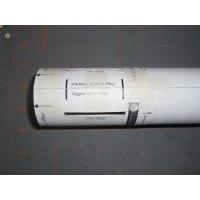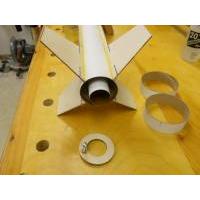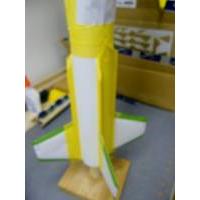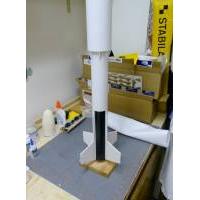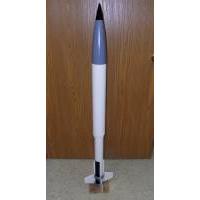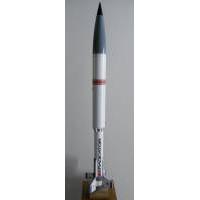| Construction Rating: | starstarstarstarstar_border |
| Flight Rating: | starstarstarstarstar_border |
| Overall Rating: | starstarstarstarstar_border |
| Published: | 2015-01-17 |
| Diameter: | 3.00 inches |
| Length: | 45.36 inches |
| Manufacturer: | Sirius Rocketry  |
| Style: | Military |
 Brief
Brief
Sirius Rocketry's Eradicator, kit number S-0017, is a "Transition Series" rocket capable of flying mid and small high power motors, and could be a Level 1 Certification rocket. Typical of all Sirius Rocketry's designs, the kit is more than a four fins and a nose cone rocket, sporting a 3.0" diameter upper body tube and nose cone and a 2.25" diameter lower body tube with two 3.0" diameter rings incorporated in the tail/fin assembly, which gives the Eradicator a unique look. This kit also comes with the typical high quality decals that Sirius Rocketry puts in all of its kits. When finished, the rocket is over 45" tall and weighs about 17 oz., depending on build style, adhesives used, and finishing. The rocket contains a 29mm motor mount with no internal thrust ring, allowing motors of varying length. Motor retention is managed with a machine screw/washer anchored in a threaded insert. All fins, strakes, and centering rings are made of 1/8" aircraft-grade plywood, and all paper tubes are heavy walled to hold up to the stresses of high powered flights. The model can be built using 1/4 inch launch lugs or rail buttons or both for flexibility.
Components
The Eradicator kit comes with the following parts:
- Kevlar Shock Cord Mount cord (24" long)
- Elastic shock cord (6' long)
- T52-H 29mm Motor Mount Tube (22" long)
- Rear Body Tube, 2.25" diameter (17" long)
- Upper Body Tube, 3.0" diameter (17" long)
- Plastic Nose Cone (PNC 3.0)
- Rail Button Kit
- Decal Sheets #1 and #2
- Motor Retention Hardware Kit
- 1/4" launch Lugs (2, 2" long)
- Tail Rings, 3.0" diameter (2, 1" long)
- Quick Link
- Ripstop Nylon Parachute (30" diameter)
- Laser-cut Plywood Parts Sheets #1 and #2
- Body-tube Marking Guide Sheet
The inclusion of the motor retention hardware and the quick link for the parachute attachment are niceties not included in all HPR kits.
Construction
The Eradicator kit came with detailed instructions that provided useful background information on construction and finishing techniques for a mid/high power rocket, and options for construction that would allow easier painting if the original paint scheme were to be chosen (I chose this option to minimize hassle with masking during painting). The instructions were very easy to follow, and the kit was a relatively simple build (rated as Skill Level 2 by Sirius Rocketry, mainly because you have to cut the fin slots yourself--see Figure 1).

Figure 1
I also used epoxy to anchor all motor mount centering rings to the motor mount and the body tubes, but used Tightbond III glue for other bonds. The parts were all of high quality and fit together well (there was a little slop in the nosecone fit that was solved with a layer of masking tape). The only change I made to the instructions provided was to not glue the rear centering ring on the motor mount until the through-the-wall fins had been installed, allowing me to filet all internal joints (fin tab to motor mount, fin tab to body tube) with Tightbond glue (see Figure 2).

Figure 2
Once the glue had dried, I then installed the rear centering ring using epoxy. The finished model was painted before the ring fins were installed per the suggestion in the instructions. The painted forward ring was carefully split, the ring slipped over the main body tube,, and then glued together before installing in the fin slots. The split was hidden from view by installing the ring with the repaired cut in the ring installed within the fin slot. The fit of the painted ring fins was so right in the fin slots that I had to carefully sand the fin slots to ensure enough room, and I judged the press-fit of the rings tight enough that I did not glue the ring fins to the fins. Time will tell if this was a good idea, but it looks great with no glue showing on finished rocket. I chose to not install the 1/4" launch lugs and opted for only the rail buttons, which were installed per the instructions (one button on the upper body, 3/4" forward of the transition area, and one button centered on the aft ring fin).
Finishing
The instructions provided good details on how to finish the rocket. I filled the tube spirals with water-thinned Elmer's Carpenter's Wood Filler and sanded smooth using 400-grit sandpaper before commencing gluing. I sanded the plywood fins and coated them with a balsa filler coat and sanded smooth before attaching them to the rocket. I carefully filetted the fins, strakes, and the eight wedge-shaped pieces that decorate the transition between the 3.0" and 2.25" body tubes. The rocket was then painted with two coats of KILZ white spray primer, sanding between coats to achieve a smooth surface. I painted the rocket body gloss white, and the nose cone gray. To match the paint scheme provided with the instructions, I then painted the top 3 inches of the nose cone black, and painted black roll patterns between the fins and strakes on opposite sides of the rocket body (see Figures 3 and 4).


Figures 3 and 4
The ring fins were treated similarly (spirals filled, primed, sanded, etc.) and painted the same gray as the nose cone. These ring fins were installed after all painting on the body was finished (see above and Figure 5).

Figure 5
As with all Sirius Rocketry's kits, the water-slide decals for the Eradicator are colorful, well made, and easy to apply. I coated the decals with one coat of Microscale Industries Inc. (MSI) Liquid Decal Film before applying, but these decals are strong enough that this coating was probably not necessary. I used MSI Micro Set as the decal setting solution.
Flight
I flew the Eradicator on an Aerotech F50-6T for the first flight. The CG was well in front of the critical point that is discussed in the instructions. It boosted arrow straight with no rotation. The parachute deployed at apogee, so the manufacturer's motor recommendation for the F50-6T as a first flight motor was a good one. The flight was high, but well in sight--perfect for a maiden voyage.
Recovery
The kit comes with a strong elastic/fabric shock cord that is attached to a heavy-duty Kevlar strong. The shock cord and 30-in. green, rip-stop nylon parachute are attached to the nose cone using a quick-link, which is a standard practice for HPR models. There is enough room in the upper body tube for an ejection baffle, and likely enough room to convert the kit to dual-deploy with careful planning (I chose to build the model stock). My first flight was recovered safely, and the parachute provided a soft landing despite not being fully deployed (some lines got wrapped around the quick-link, so the parachute was not completed symmetrical). The 3"-diameter parachute bay takes a lot of wadding in addition to the 6" chute Nomex parachute protector I added, but there were no scorch marks on the parachute--a very successful recovery.
Summary
In summary the Sirius Rocketry Eradicator is a well-designed, eye-catching rocket that flies arrow straight due to the good fin alignment achieved with use of the fin slotting template and good building practices. I will fly this model on F and G motors for sure, and the construction, if done properly, will certainly allow small H motors as well. The build was fairly easy and the results look great, both on and off the field.
 |
 |
Flights
Sponsored Ads
 |
 |
